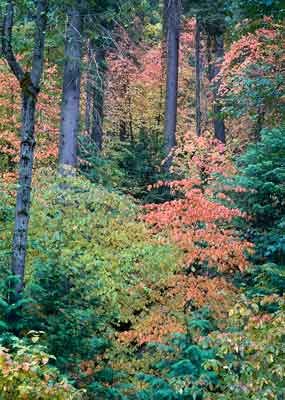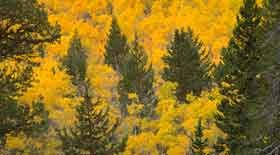
Photos by Christine Loberg Leaves turn green each spring as they use pigments (chlorophyll, xanthophyll, and carotenoids) to harness the sun’s energy. The chlorophyll absorbs red and blue wavelengths but not green ones that are reflected back to our eyes; hiding underneath the chlorophyll are the other compounds for photosynthesis. As temperatures cool and days get shorter, leaves on deciduous trees stop producing new chlorophyll, and the familiar green color breaks down to reveal the other pigments that have been masked all season. Chlorophyll is expensive to make (for the tree); so when there isn't enough light to make it worth expending energy on, the green fades and the colors beneath show. This is a photoperiod process, not a temperature-dependent process. How is the Red Pigment Made? What Colors Do Leaves Change to in a Variety of Yosemite’s Tree Species? Quaking aspen: Yellow 
What Weather is Needed Do Some New Leaves Grow during Winter? Where in Yosemite Promises Good Color? A search for quaking aspen, for instance, can be found in some favorite glades within the park. Easy for leaf-peepers to drive by are roadside stands along the Tioga Road near the Tuolumne Grove trailhead and the Yosemite Creek picnic area, while more isloated aspens grow along the Glacier Point Road past Summit Meadow. Plus, consider a gentle walk along the old road from Badger Pass ski area to Bridalveil Creek Campground that leads to aspen groves. Read on for more suggestions on where to see fall color:
When Will Color Be at its Height in Yosemite This Year?
|
Last updated: March 1, 2015
